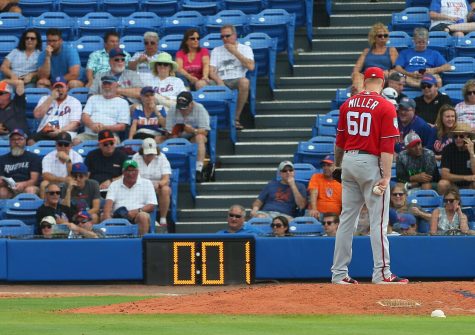Dividing the fanbase: baseball’s pitch clock
March 8, 2023
The sound of the baseball as it hits the catcher’s glove is a sound we’re all too familiar with. Also, the 30 seconds between the pitches is something fans have been familiar with. But, unlike many problems in baseball, those 30 seconds do have a resolution.
After the 2022 season, the MLB decided to implement what’s now known as the pitch clock. They also added a variety of new rules, such as the banning of the shift and larger bases. The rules for the pitch clock include the following; 15 seconds for a pitcher to throw a pitch with the bases empty; 20 seconds for a pitcher to pitch with a runner on the bases. Hitters may only have 1 timeout per at-bat, and the batter must be in the box before 8 seconds on the clock. For consequences of not following these rules include, an automatic strike if the batter doesn’t follow the 7-second rule, and an automatic ball if the pitcher isn’t in motion before the 15 seconds end.

As for any rule change, it’s not to say this hasn’t divided the generations of baseball watchers. Many traditionalists are calling it a sham to try and speed up the game, but many newcomers say a fast, more offensive-powered game is just what America’s pastime needs to survive. As for the result of the pitch clock, games have averaged 3.3 more runs per game, along with an average of 45 minutes shorter games than last season. So, we can firmly say the results that the MLB wanted are clearly on display for all to see.
Changing the game always causes controversy, but like anything, people learn to adapt. In a few short years, the pitch clock will be a vital part of baseball. Arguing over it is pointless, simply because the clock isn’t going anywhere. Viewership is up, baseball is appealing to a younger generation, and we’re seeing a revitalization of the game. If you ask me, the pitch clock was solemnly the correct choice.


